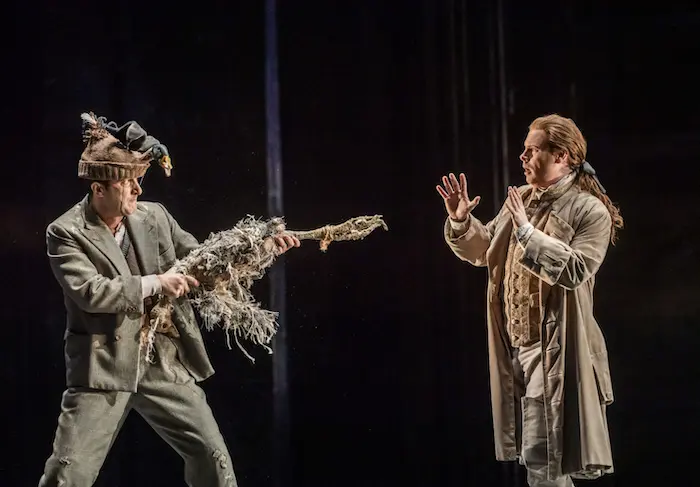Wolfgang Amadeus Mozart’s opera, The Magic Flute, is one of the most beloved and frequently performed works in the classical music repertoire. Composed in 1791, during the last year of his life, this opera is a remarkable blend of enchanting music, fairy-tale magic, and profound symbolism. This article explores the creation, themes, and significance of The Magic Flute.
I. Creation and Context
A Commissioned Work
The Magic Flute was commissioned by Emanuel Schikaneder, a fellow Freemason, and a notable actor, singer, and impresario. Schikaneder owned the Theater auf der Wieden in Vienna, where the opera premiered. His troupe specialized in popular theater, including singspiel, a form of German-language music drama that includes spoken dialogue. Schikaneder himself wrote the libretto for The Magic Flute, incorporating Masonic elements and the Enlightenment ideals he shared with Mozart.
Mozart’s Final Year
Mozart composed The Magic Flute during a turbulent period. Financial difficulties and declining health plagued him, yet his creativity remained undiminished. This opera, alongside his Requiem, represents the pinnacle of his late compositional output. Despite his struggles, Mozart infused The Magic Flute with a joyful, life-affirming spirit.
II. Plot Overview: A Fairy-Tale Narrative
The Magic Flute follows the adventures of Prince Tamino and his quest to rescue Pamina, the daughter of the Queen of the Night, from the clutches of the high priest Sarastro. Tamino is assisted by a bird-catcher named Papageno. The opera is divided into two acts, filled with trials, magical instruments, and encounters with mystical creatures.
Act I
The opera opens with Prince Tamino fleeing from a serpent. He faints, and three ladies, servants of the Queen of the Night, save him. They show him a portrait of Pamina, and he instantly falls in love with her. The Queen of the Night persuades Tamino to rescue Pamina, who has been captured by Sarastro. Tamino, accompanied by Papageno, embarks on this quest. The ladies give them a magic flute and enchanted bells to aid them.
Act II
In Sarastro’s realm, Tamino and Pamina undergo a series of trials to prove their worthiness. Tamino’s steadfastness and Pamina’s devotion are tested, but with the help of the magic flute, they overcome all obstacles. In contrast, Papageno, more concerned with earthly pleasures, fails his trials but is granted a simple happiness with Papagena. The opera concludes with the defeat of the Queen of the Night and the triumph of wisdom and virtue, symbolized by the union of Tamino and Pamina.
III. Musical Highlights
Overture
The overture to The Magic Flute is a masterpiece in itself, blending solemnity and playfulness. It introduces the Masonic themes with three majestic chords, followed by a lively fugue. This sets the stage for the opera’s mix of the serious and the whimsical.
Queen of the Night’s Aria
One of the most famous arias in all of opera is the Queen of the Night’s “Der Hölle Rache kocht in meinem Herzen” (“Hell’s vengeance boils in my heart”). This aria is a showcase for coloratura sopranos, requiring extraordinary vocal agility and range. The Queen’s fury and desperation are vividly conveyed through the music.
Tamino and Pamina’s Duets
Tamino and Pamina’s duets, particularly “Bei Männern welche Liebe fühlen” (“In men, who feel love”), highlight the purity and nobility of their love. These lyrical passages contrast with the Queen’s fiery arias and provide emotional depth to their characters.
Papageno’s Songs
Papageno’s songs, such as “Der Vogelfänger bin ich ja” (“Yes, I am the bird catcher”), bring a light-hearted, folk-like quality to the opera. His character adds humor and humanity, balancing the opera’s more serious themes.
IV. Symbolism and Themes
Masonic Symbolism
The Magic Flute is imbued with Masonic symbolism. Both Mozart and Schikaneder were Freemasons, and the opera reflects their beliefs. The number three is significant in Masonic ritual, and it appears throughout the opera, from the three chords in the overture to the three trials Tamino faces. The journey from darkness to light, represented by Tamino and Pamina’s trials, mirrors the Masonic quest for wisdom and enlightenment.
Enlightenment Ideals
The opera also reflects Enlightenment ideals of reason, virtue, and wisdom. Sarastro’s realm represents the enlightened state, where knowledge and reason prevail over superstition and tyranny, embodied by the Queen of the Night. The characters’ trials symbolize personal growth and the pursuit of higher ideals.
Conflict of Good and Evil
At its core, The Magic Flute is a tale of the conflict between good and evil, light and darkness. The Queen of the Night’s malevolence is pitted against Sarastro’s benevolence. This duality is not just a moral battle but also an allegory of the struggle for enlightenment against ignorance.
V. Cultural Impact
Reception and Legacy
The Magic Flute premiered on September 30, 1791, at the Theater auf der Wieden, just two months before Mozart’s death. It was an immediate success, praised for its engaging story and sublime music. Its popularity has endured, making it a staple of opera houses worldwide.
Adaptations and Interpretations
Over the centuries, The Magic Flute has inspired numerous adaptations and interpretations, from animated films to avant-garde productions. Its universal themes and captivating music continue to resonate with audiences of all ages.
Educational Value
The opera’s rich symbolism and accessible storyline make it a favorite in educational settings. It introduces students to classical music and opera while imparting lessons on virtue, courage, and wisdom.
See Also: What Makes Classical Music Complicated?
VI. Conclusion
Wolfgang Amadeus Mozart’s The Magic Flute is a timeless masterpiece that combines enchanting music, a compelling narrative, and profound symbolism. Its blend of fairy-tale magic and Enlightenment ideals makes it unique in the operatic repertoire. From its famous arias to its deeper philosophical messages, The Magic Flute continues to captivate and inspire audiences around the world. Its legacy as one of the greatest operas ever composed remains unchallenged, a testament to Mozart’s genius and enduring influence.

